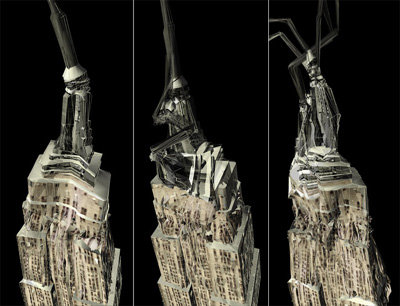Mark Napier
dal 11/4/2007 al 18/5/2007
Segnalato da
11/4/2007
Mark Napier
Bitforms Gallery, New York
A symbol of the human desire to monumentalize ideas in physical form, the Empire State Building is a subject of artist's artwork in the past years. This icon of American hegemony is key to exploring shifting structures of power, specifically the transition from steel to software as the medium of power in our time.

New Work
Mark Napier debuts new software art and prints at bitforms gallery in New York.
One of the select few artists whose Internet art has been collected and commissioned by prominent art institutions, Mark Napier is known for creating work that challenges traditional rules of ownership, authority, and permanence. Over the past decade he has developed custom software as an art medium, and this exhibition features virtual objects that hover between the material and immaterial.
"Increasingly we live and navigate in a world composed of energy: electrical, magnetic and light," says Napier. "Digital media infuse our lives as never before. In this media environment, power is no longer associated with physical objects, but with the persistence of ideas in the collective consciousness of the media."
A symbol of the human desire to monumentalize ideas in physical form, the Empire State Building is a subject of Mark Napier's artwork in the past four years. This icon of American hegemony is key to exploring shifting structures of power, specifically the transition from steel to software as the medium of power in our time.
The free-floating virtual skyscraper appearing in Mark Napier's recent work is governed by rules that do not apply to the natural world, a signal of our transition as a civilization. In Smoke, a generative software installation projected on the gallery wall, the Empire State Building appears to soften and melt, writhing almost organically, then struggle to return to it's original form. Teetering on the line between organism and architecture, Smoke speaks to a morphological tension between static physical structures of power and those that are information-based, organic and malleable.
Another software work in the exhibition, displayed on screen, investigates the notion that we ourselves are vessels of information. This live installation delicately animates bare human flesh over the surface of the building, sensuously enveloping its structure and forming a skin.
Originally trained as a painter, Mark Napier's visual vocabulary is informed by Cubist representations of space. Specifically considering the early work of Picasso and Braque, Napier created custom software to simulate a "soft" skyscraper that is thrown and bent by unseen forces. Every iteration of the building's movement is captured, forming a densely layered record in a perpetual state of cubist deconstruction.
Displaying multiple perspectives of the same virtual form, the prints in the exhibit reflect the anxiety and tension of a transitional era of history. Named after the Cyclops, early artisans of Greek mythology, imagery in Napier's recent prints metaphorically follow the birth, rise and fall of a being that lives and dies by its ability to fashion material forms. Historically the Cyclops were blacksmiths that forged weapons for the gods, and ultimately fell from grace as they were blamed for the destruction caused by their handiwork. In "Cyclops Descends" flesh tones and fragments of architecture appear frozen, as if shattering and re-forming in the same instant.
Bitforms Gallery
529 west 20th New York



